Taxation Law Assignment: Income Tax and Property Rental Analysis
VerifiedAdded on 2020/04/07
|9
|2215
|56
Homework Assignment
AI Summary
This taxation law assignment addresses several scenarios to assess tax implications. Question 1 focuses on calculating net capital profit or loss from asset sales, differentiating between personal use assets and collectibles, and determining taxability based on acquisition costs and holding periods. Question 2 analyzes a loan provided by an employer, calculating fringe benefits based on the difference between statutory and actual interest rates, considering tax deductible interest expenses, and determining the final taxation amount. Question 3 examines a property rental agreement between a husband and wife, clarifying the distribution of profit and loss and the tax liabilities of each party. Question 4 discusses the legal principles of tax avoidance, referencing the IRC v Duke of Westminster case and its relevance in modern scenarios. Finally, Question 5 evaluates the tax treatment of income received from timber clearing, distinguishing between lump-sum payments (capital receipts) and recurring payments, and determining the applicable tax rates.

1
Taxation Law
<Student ID>
<Student Name>
<University Name>
Taxation Law
<Student ID>
<Student Name>
<University Name>
Paraphrase This Document
Need a fresh take? Get an instant paraphrase of this document with our AI Paraphraser

2
Contents
Question 1..................................................................................................................................3
Question 2..................................................................................................................................4
Question 3..................................................................................................................................5
Question 4..................................................................................................................................6
Question 5..................................................................................................................................7
References..................................................................................................................................8
Contents
Question 1..................................................................................................................................3
Question 2..................................................................................................................................4
Question 3..................................................................................................................................5
Question 4..................................................................................................................................6
Question 5..................................................................................................................................7
References..................................................................................................................................8
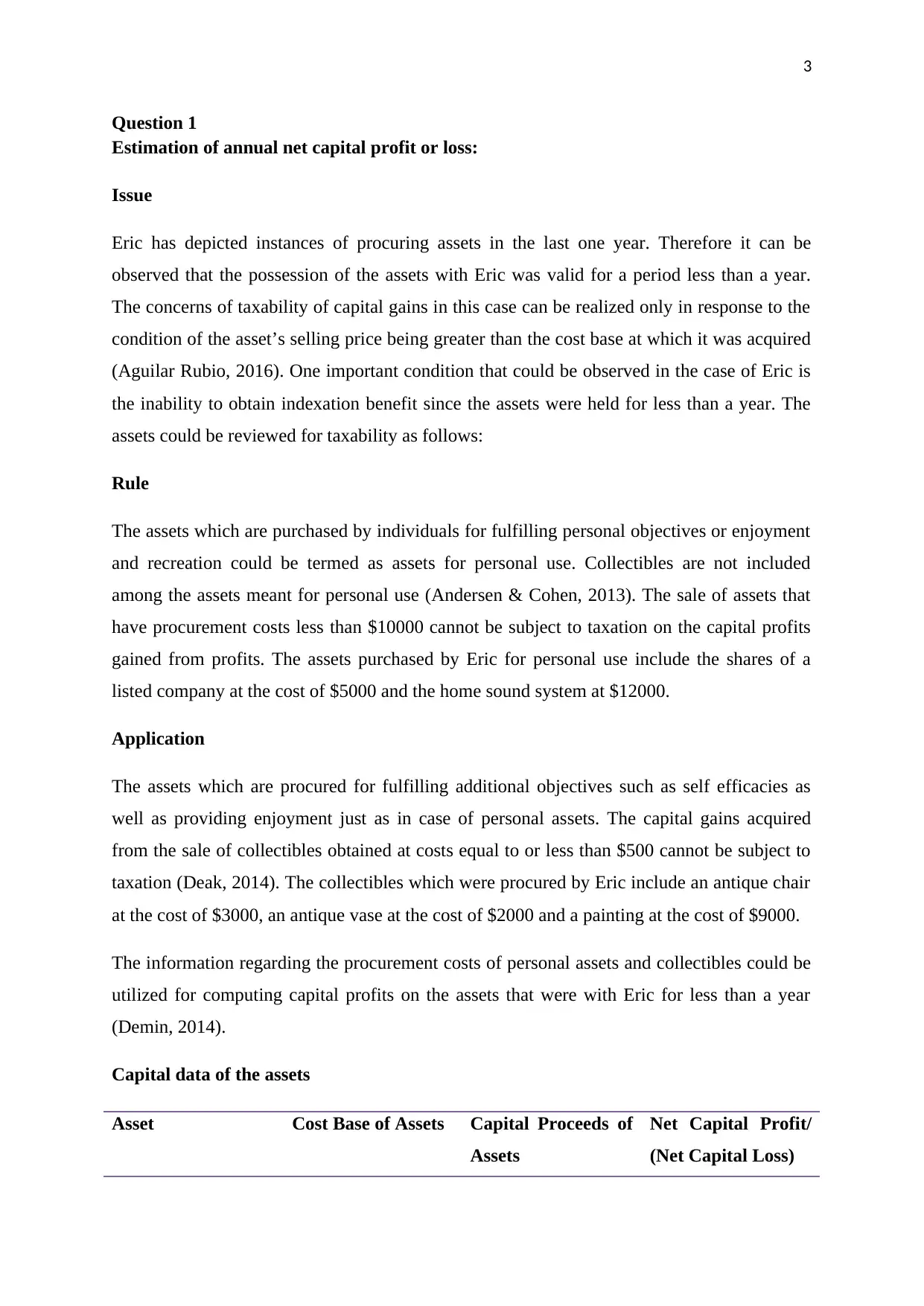
3
Question 1
Estimation of annual net capital profit or loss:
Issue
Eric has depicted instances of procuring assets in the last one year. Therefore it can be
observed that the possession of the assets with Eric was valid for a period less than a year.
The concerns of taxability of capital gains in this case can be realized only in response to the
condition of the asset’s selling price being greater than the cost base at which it was acquired
(Aguilar Rubio, 2016). One important condition that could be observed in the case of Eric is
the inability to obtain indexation benefit since the assets were held for less than a year. The
assets could be reviewed for taxability as follows:
Rule
The assets which are purchased by individuals for fulfilling personal objectives or enjoyment
and recreation could be termed as assets for personal use. Collectibles are not included
among the assets meant for personal use (Andersen & Cohen, 2013). The sale of assets that
have procurement costs less than $10000 cannot be subject to taxation on the capital profits
gained from profits. The assets purchased by Eric for personal use include the shares of a
listed company at the cost of $5000 and the home sound system at $12000.
Application
The assets which are procured for fulfilling additional objectives such as self efficacies as
well as providing enjoyment just as in case of personal assets. The capital gains acquired
from the sale of collectibles obtained at costs equal to or less than $500 cannot be subject to
taxation (Deak, 2014). The collectibles which were procured by Eric include an antique chair
at the cost of $3000, an antique vase at the cost of $2000 and a painting at the cost of $9000.
The information regarding the procurement costs of personal assets and collectibles could be
utilized for computing capital profits on the assets that were with Eric for less than a year
(Demin, 2014).
Capital data of the assets
Asset Cost Base of Assets Capital Proceeds of
Assets
Net Capital Profit/
(Net Capital Loss)
Question 1
Estimation of annual net capital profit or loss:
Issue
Eric has depicted instances of procuring assets in the last one year. Therefore it can be
observed that the possession of the assets with Eric was valid for a period less than a year.
The concerns of taxability of capital gains in this case can be realized only in response to the
condition of the asset’s selling price being greater than the cost base at which it was acquired
(Aguilar Rubio, 2016). One important condition that could be observed in the case of Eric is
the inability to obtain indexation benefit since the assets were held for less than a year. The
assets could be reviewed for taxability as follows:
Rule
The assets which are purchased by individuals for fulfilling personal objectives or enjoyment
and recreation could be termed as assets for personal use. Collectibles are not included
among the assets meant for personal use (Andersen & Cohen, 2013). The sale of assets that
have procurement costs less than $10000 cannot be subject to taxation on the capital profits
gained from profits. The assets purchased by Eric for personal use include the shares of a
listed company at the cost of $5000 and the home sound system at $12000.
Application
The assets which are procured for fulfilling additional objectives such as self efficacies as
well as providing enjoyment just as in case of personal assets. The capital gains acquired
from the sale of collectibles obtained at costs equal to or less than $500 cannot be subject to
taxation (Deak, 2014). The collectibles which were procured by Eric include an antique chair
at the cost of $3000, an antique vase at the cost of $2000 and a painting at the cost of $9000.
The information regarding the procurement costs of personal assets and collectibles could be
utilized for computing capital profits on the assets that were with Eric for less than a year
(Demin, 2014).
Capital data of the assets
Asset Cost Base of Assets Capital Proceeds of
Assets
Net Capital Profit/
(Net Capital Loss)
⊘ This is a preview!⊘
Do you want full access?
Subscribe today to unlock all pages.

Trusted by 1+ million students worldwide

4
Home Sound
System
12,000 11000 (1000) Loss
Shares in listed
company
5,000 20000 15000 Profit
Painting 9,000 1000 (8000) Loss
Antique Chair 3,000 1000 (2000) Loss
Antique Vase 2,000 3000 1000 Profit
Net Capital
Gain/Loss
5000 Profit
Conclusion
The total procurement costs of the personal assets acquired by Eric were identified to be more
than $10000 that implies that capital gains from the sale of personal assets could be taxable.
The collectibles were also priced at more than $500 which indicates that the capital profits
from sale of collectibles can be subject to taxation (Ezcurra, 2016). The calculation of net
profit can be calculated by offsetting the annual capital losses with capital profit.
Question 2
Issue
The case in question implies the loan of $1 million taken by Brian from his employer for a
period of three years on a special privilege of 1% interest rate.
Rule
The considerable margin between the prevailing interest rates and the special interest rate is
liable for classifying the loan as a fringe benefit. Therefore, statutory interest rate has to be
applied in the case of benefit derived from the loan and the interest rate that could be applied
in this case is found to be 5.65% (Fontana, 2014).
Application
In first step, the calculation of the loan fringe benefit would be based on the precedent of
excluding the deductible rule. The deductible rule emphasizes on the factor that interest on
the loan by implementing actual rate of interest should be subtracted from that obtained using
Home Sound
System
12,000 11000 (1000) Loss
Shares in listed
company
5,000 20000 15000 Profit
Painting 9,000 1000 (8000) Loss
Antique Chair 3,000 1000 (2000) Loss
Antique Vase 2,000 3000 1000 Profit
Net Capital
Gain/Loss
5000 Profit
Conclusion
The total procurement costs of the personal assets acquired by Eric were identified to be more
than $10000 that implies that capital gains from the sale of personal assets could be taxable.
The collectibles were also priced at more than $500 which indicates that the capital profits
from sale of collectibles can be subject to taxation (Ezcurra, 2016). The calculation of net
profit can be calculated by offsetting the annual capital losses with capital profit.
Question 2
Issue
The case in question implies the loan of $1 million taken by Brian from his employer for a
period of three years on a special privilege of 1% interest rate.
Rule
The considerable margin between the prevailing interest rates and the special interest rate is
liable for classifying the loan as a fringe benefit. Therefore, statutory interest rate has to be
applied in the case of benefit derived from the loan and the interest rate that could be applied
in this case is found to be 5.65% (Fontana, 2014).
Application
In first step, the calculation of the loan fringe benefit would be based on the precedent of
excluding the deductible rule. The deductible rule emphasizes on the factor that interest on
the loan by implementing actual rate of interest should be subtracted from that obtained using
Paraphrase This Document
Need a fresh take? Get an instant paraphrase of this document with our AI Paraphraser
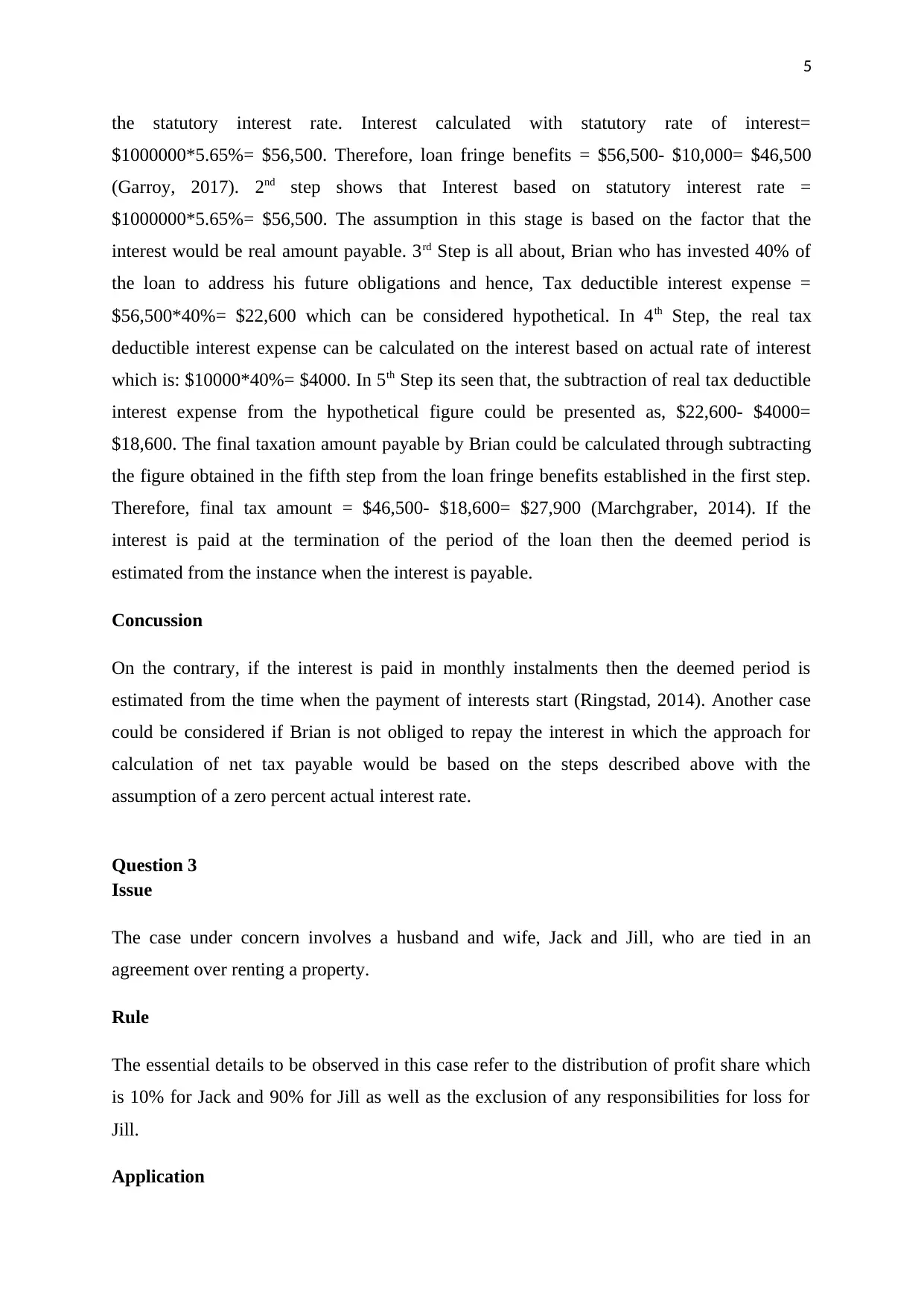
5
the statutory interest rate. Interest calculated with statutory rate of interest=
$1000000*5.65%= $56,500. Therefore, loan fringe benefits = $56,500- $10,000= $46,500
(Garroy, 2017). 2nd step shows that Interest based on statutory interest rate =
$1000000*5.65%= $56,500. The assumption in this stage is based on the factor that the
interest would be real amount payable. 3rd Step is all about, Brian who has invested 40% of
the loan to address his future obligations and hence, Tax deductible interest expense =
$56,500*40%= $22,600 which can be considered hypothetical. In 4th Step, the real tax
deductible interest expense can be calculated on the interest based on actual rate of interest
which is: $10000*40%= $4000. In 5th Step its seen that, the subtraction of real tax deductible
interest expense from the hypothetical figure could be presented as, $22,600- $4000=
$18,600. The final taxation amount payable by Brian could be calculated through subtracting
the figure obtained in the fifth step from the loan fringe benefits established in the first step.
Therefore, final tax amount = $46,500- $18,600= $27,900 (Marchgraber, 2014). If the
interest is paid at the termination of the period of the loan then the deemed period is
estimated from the instance when the interest is payable.
Concussion
On the contrary, if the interest is paid in monthly instalments then the deemed period is
estimated from the time when the payment of interests start (Ringstad, 2014). Another case
could be considered if Brian is not obliged to repay the interest in which the approach for
calculation of net tax payable would be based on the steps described above with the
assumption of a zero percent actual interest rate.
Question 3
Issue
The case under concern involves a husband and wife, Jack and Jill, who are tied in an
agreement over renting a property.
Rule
The essential details to be observed in this case refer to the distribution of profit share which
is 10% for Jack and 90% for Jill as well as the exclusion of any responsibilities for loss for
Jill.
Application
the statutory interest rate. Interest calculated with statutory rate of interest=
$1000000*5.65%= $56,500. Therefore, loan fringe benefits = $56,500- $10,000= $46,500
(Garroy, 2017). 2nd step shows that Interest based on statutory interest rate =
$1000000*5.65%= $56,500. The assumption in this stage is based on the factor that the
interest would be real amount payable. 3rd Step is all about, Brian who has invested 40% of
the loan to address his future obligations and hence, Tax deductible interest expense =
$56,500*40%= $22,600 which can be considered hypothetical. In 4th Step, the real tax
deductible interest expense can be calculated on the interest based on actual rate of interest
which is: $10000*40%= $4000. In 5th Step its seen that, the subtraction of real tax deductible
interest expense from the hypothetical figure could be presented as, $22,600- $4000=
$18,600. The final taxation amount payable by Brian could be calculated through subtracting
the figure obtained in the fifth step from the loan fringe benefits established in the first step.
Therefore, final tax amount = $46,500- $18,600= $27,900 (Marchgraber, 2014). If the
interest is paid at the termination of the period of the loan then the deemed period is
estimated from the instance when the interest is payable.
Concussion
On the contrary, if the interest is paid in monthly instalments then the deemed period is
estimated from the time when the payment of interests start (Ringstad, 2014). Another case
could be considered if Brian is not obliged to repay the interest in which the approach for
calculation of net tax payable would be based on the steps described above with the
assumption of a zero percent actual interest rate.
Question 3
Issue
The case under concern involves a husband and wife, Jack and Jill, who are tied in an
agreement over renting a property.
Rule
The essential details to be observed in this case refer to the distribution of profit share which
is 10% for Jack and 90% for Jill as well as the exclusion of any responsibilities for loss for
Jill.
Application
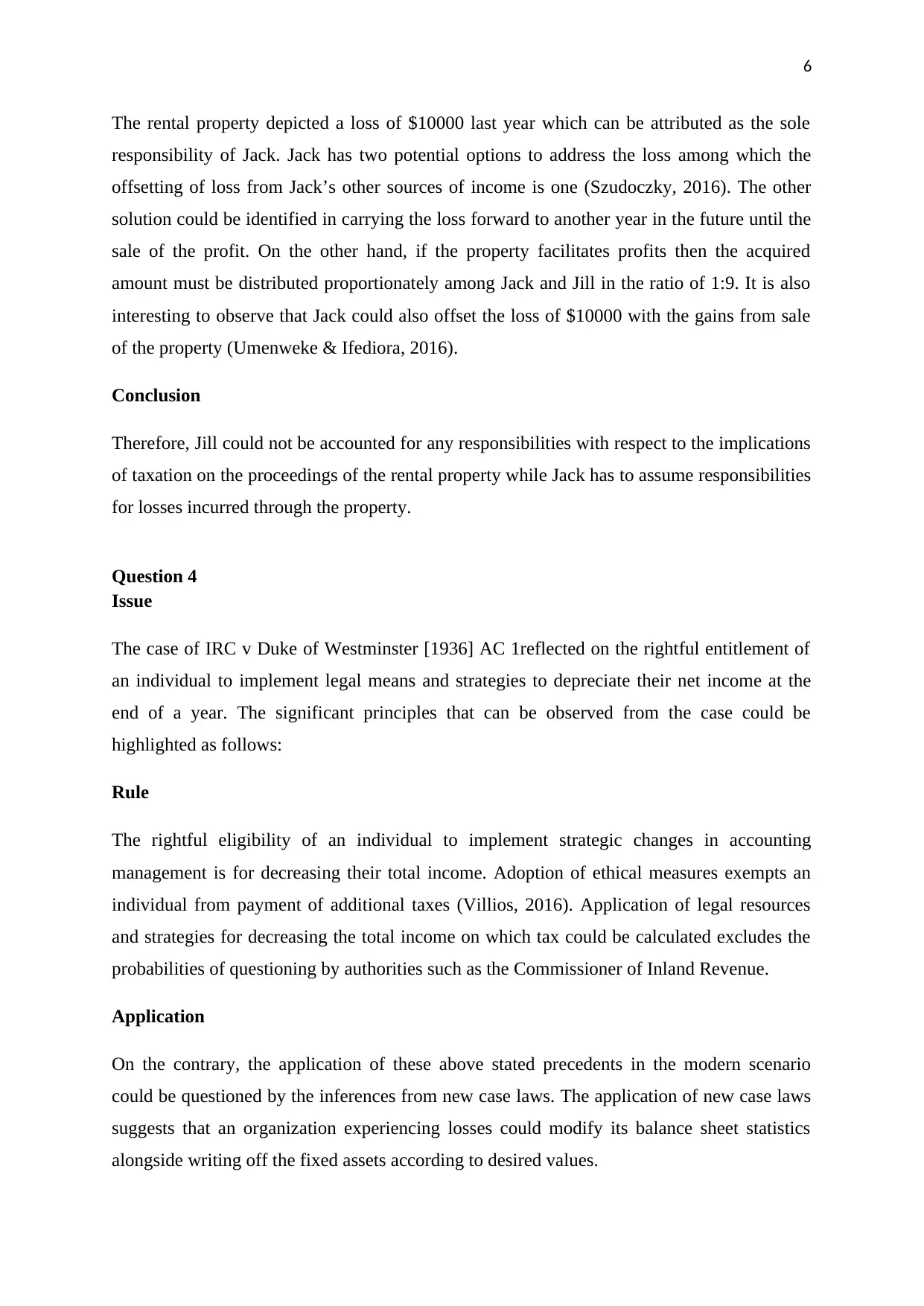
6
The rental property depicted a loss of $10000 last year which can be attributed as the sole
responsibility of Jack. Jack has two potential options to address the loss among which the
offsetting of loss from Jack’s other sources of income is one (Szudoczky, 2016). The other
solution could be identified in carrying the loss forward to another year in the future until the
sale of the profit. On the other hand, if the property facilitates profits then the acquired
amount must be distributed proportionately among Jack and Jill in the ratio of 1:9. It is also
interesting to observe that Jack could also offset the loss of $10000 with the gains from sale
of the property (Umenweke & Ifediora, 2016).
Conclusion
Therefore, Jill could not be accounted for any responsibilities with respect to the implications
of taxation on the proceedings of the rental property while Jack has to assume responsibilities
for losses incurred through the property.
Question 4
Issue
The case of IRC v Duke of Westminster [1936] AC 1reflected on the rightful entitlement of
an individual to implement legal means and strategies to depreciate their net income at the
end of a year. The significant principles that can be observed from the case could be
highlighted as follows:
Rule
The rightful eligibility of an individual to implement strategic changes in accounting
management is for decreasing their total income. Adoption of ethical measures exempts an
individual from payment of additional taxes (Villios, 2016). Application of legal resources
and strategies for decreasing the total income on which tax could be calculated excludes the
probabilities of questioning by authorities such as the Commissioner of Inland Revenue.
Application
On the contrary, the application of these above stated precedents in the modern scenario
could be questioned by the inferences from new case laws. The application of new case laws
suggests that an organization experiencing losses could modify its balance sheet statistics
alongside writing off the fixed assets according to desired values.
The rental property depicted a loss of $10000 last year which can be attributed as the sole
responsibility of Jack. Jack has two potential options to address the loss among which the
offsetting of loss from Jack’s other sources of income is one (Szudoczky, 2016). The other
solution could be identified in carrying the loss forward to another year in the future until the
sale of the profit. On the other hand, if the property facilitates profits then the acquired
amount must be distributed proportionately among Jack and Jill in the ratio of 1:9. It is also
interesting to observe that Jack could also offset the loss of $10000 with the gains from sale
of the property (Umenweke & Ifediora, 2016).
Conclusion
Therefore, Jill could not be accounted for any responsibilities with respect to the implications
of taxation on the proceedings of the rental property while Jack has to assume responsibilities
for losses incurred through the property.
Question 4
Issue
The case of IRC v Duke of Westminster [1936] AC 1reflected on the rightful entitlement of
an individual to implement legal means and strategies to depreciate their net income at the
end of a year. The significant principles that can be observed from the case could be
highlighted as follows:
Rule
The rightful eligibility of an individual to implement strategic changes in accounting
management is for decreasing their total income. Adoption of ethical measures exempts an
individual from payment of additional taxes (Villios, 2016). Application of legal resources
and strategies for decreasing the total income on which tax could be calculated excludes the
probabilities of questioning by authorities such as the Commissioner of Inland Revenue.
Application
On the contrary, the application of these above stated precedents in the modern scenario
could be questioned by the inferences from new case laws. The application of new case laws
suggests that an organization experiencing losses could modify its balance sheet statistics
alongside writing off the fixed assets according to desired values.
⊘ This is a preview!⊘
Do you want full access?
Subscribe today to unlock all pages.

Trusted by 1+ million students worldwide
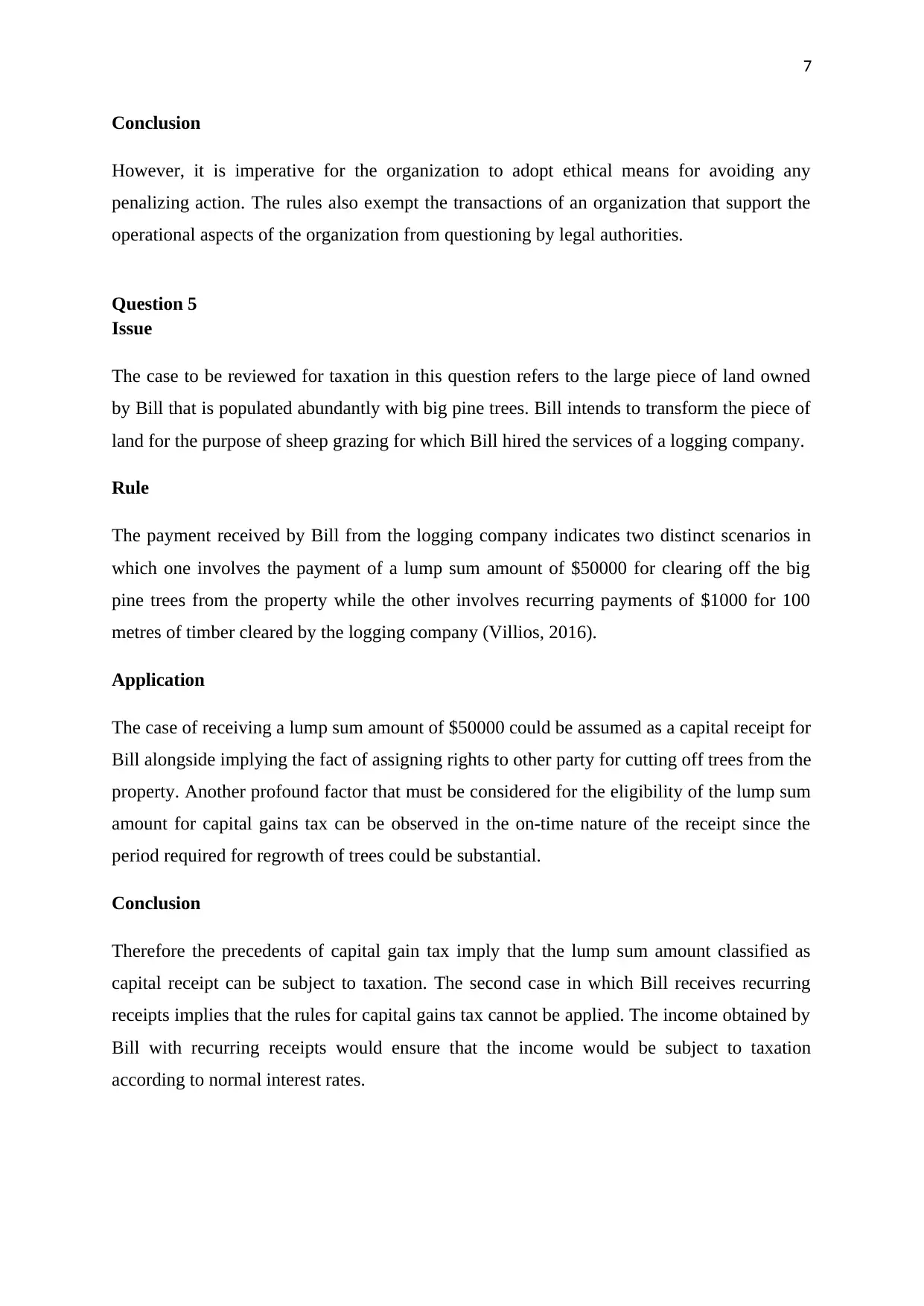
7
Conclusion
However, it is imperative for the organization to adopt ethical means for avoiding any
penalizing action. The rules also exempt the transactions of an organization that support the
operational aspects of the organization from questioning by legal authorities.
Question 5
Issue
The case to be reviewed for taxation in this question refers to the large piece of land owned
by Bill that is populated abundantly with big pine trees. Bill intends to transform the piece of
land for the purpose of sheep grazing for which Bill hired the services of a logging company.
Rule
The payment received by Bill from the logging company indicates two distinct scenarios in
which one involves the payment of a lump sum amount of $50000 for clearing off the big
pine trees from the property while the other involves recurring payments of $1000 for 100
metres of timber cleared by the logging company (Villios, 2016).
Application
The case of receiving a lump sum amount of $50000 could be assumed as a capital receipt for
Bill alongside implying the fact of assigning rights to other party for cutting off trees from the
property. Another profound factor that must be considered for the eligibility of the lump sum
amount for capital gains tax can be observed in the on-time nature of the receipt since the
period required for regrowth of trees could be substantial.
Conclusion
Therefore the precedents of capital gain tax imply that the lump sum amount classified as
capital receipt can be subject to taxation. The second case in which Bill receives recurring
receipts implies that the rules for capital gains tax cannot be applied. The income obtained by
Bill with recurring receipts would ensure that the income would be subject to taxation
according to normal interest rates.
Conclusion
However, it is imperative for the organization to adopt ethical means for avoiding any
penalizing action. The rules also exempt the transactions of an organization that support the
operational aspects of the organization from questioning by legal authorities.
Question 5
Issue
The case to be reviewed for taxation in this question refers to the large piece of land owned
by Bill that is populated abundantly with big pine trees. Bill intends to transform the piece of
land for the purpose of sheep grazing for which Bill hired the services of a logging company.
Rule
The payment received by Bill from the logging company indicates two distinct scenarios in
which one involves the payment of a lump sum amount of $50000 for clearing off the big
pine trees from the property while the other involves recurring payments of $1000 for 100
metres of timber cleared by the logging company (Villios, 2016).
Application
The case of receiving a lump sum amount of $50000 could be assumed as a capital receipt for
Bill alongside implying the fact of assigning rights to other party for cutting off trees from the
property. Another profound factor that must be considered for the eligibility of the lump sum
amount for capital gains tax can be observed in the on-time nature of the receipt since the
period required for regrowth of trees could be substantial.
Conclusion
Therefore the precedents of capital gain tax imply that the lump sum amount classified as
capital receipt can be subject to taxation. The second case in which Bill receives recurring
receipts implies that the rules for capital gains tax cannot be applied. The income obtained by
Bill with recurring receipts would ensure that the income would be subject to taxation
according to normal interest rates.
Paraphrase This Document
Need a fresh take? Get an instant paraphrase of this document with our AI Paraphraser
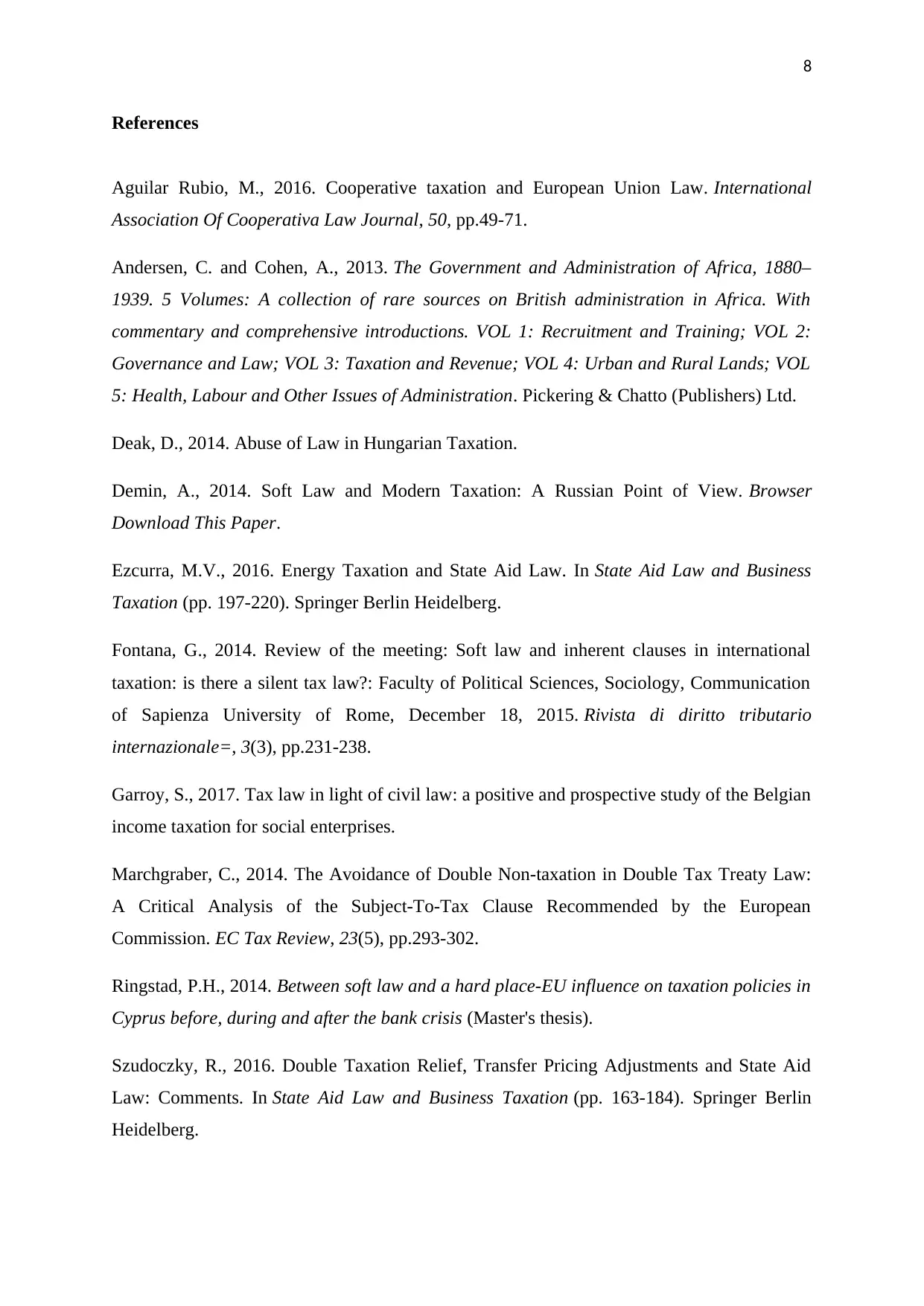
8
References
Aguilar Rubio, M., 2016. Cooperative taxation and European Union Law. International
Association Of Cooperativa Law Journal, 50, pp.49-71.
Andersen, C. and Cohen, A., 2013. The Government and Administration of Africa, 1880–
1939. 5 Volumes: A collection of rare sources on British administration in Africa. With
commentary and comprehensive introductions. VOL 1: Recruitment and Training; VOL 2:
Governance and Law; VOL 3: Taxation and Revenue; VOL 4: Urban and Rural Lands; VOL
5: Health, Labour and Other Issues of Administration. Pickering & Chatto (Publishers) Ltd.
Deak, D., 2014. Abuse of Law in Hungarian Taxation.
Demin, A., 2014. Soft Law and Modern Taxation: A Russian Point of View. Browser
Download This Paper.
Ezcurra, M.V., 2016. Energy Taxation and State Aid Law. In State Aid Law and Business
Taxation (pp. 197-220). Springer Berlin Heidelberg.
Fontana, G., 2014. Review of the meeting: Soft law and inherent clauses in international
taxation: is there a silent tax law?: Faculty of Political Sciences, Sociology, Communication
of Sapienza University of Rome, December 18, 2015. Rivista di diritto tributario
internazionale=, 3(3), pp.231-238.
Garroy, S., 2017. Tax law in light of civil law: a positive and prospective study of the Belgian
income taxation for social enterprises.
Marchgraber, C., 2014. The Avoidance of Double Non-taxation in Double Tax Treaty Law:
A Critical Analysis of the Subject-To-Tax Clause Recommended by the European
Commission. EC Tax Review, 23(5), pp.293-302.
Ringstad, P.H., 2014. Between soft law and a hard place-EU influence on taxation policies in
Cyprus before, during and after the bank crisis (Master's thesis).
Szudoczky, R., 2016. Double Taxation Relief, Transfer Pricing Adjustments and State Aid
Law: Comments. In State Aid Law and Business Taxation (pp. 163-184). Springer Berlin
Heidelberg.
References
Aguilar Rubio, M., 2016. Cooperative taxation and European Union Law. International
Association Of Cooperativa Law Journal, 50, pp.49-71.
Andersen, C. and Cohen, A., 2013. The Government and Administration of Africa, 1880–
1939. 5 Volumes: A collection of rare sources on British administration in Africa. With
commentary and comprehensive introductions. VOL 1: Recruitment and Training; VOL 2:
Governance and Law; VOL 3: Taxation and Revenue; VOL 4: Urban and Rural Lands; VOL
5: Health, Labour and Other Issues of Administration. Pickering & Chatto (Publishers) Ltd.
Deak, D., 2014. Abuse of Law in Hungarian Taxation.
Demin, A., 2014. Soft Law and Modern Taxation: A Russian Point of View. Browser
Download This Paper.
Ezcurra, M.V., 2016. Energy Taxation and State Aid Law. In State Aid Law and Business
Taxation (pp. 197-220). Springer Berlin Heidelberg.
Fontana, G., 2014. Review of the meeting: Soft law and inherent clauses in international
taxation: is there a silent tax law?: Faculty of Political Sciences, Sociology, Communication
of Sapienza University of Rome, December 18, 2015. Rivista di diritto tributario
internazionale=, 3(3), pp.231-238.
Garroy, S., 2017. Tax law in light of civil law: a positive and prospective study of the Belgian
income taxation for social enterprises.
Marchgraber, C., 2014. The Avoidance of Double Non-taxation in Double Tax Treaty Law:
A Critical Analysis of the Subject-To-Tax Clause Recommended by the European
Commission. EC Tax Review, 23(5), pp.293-302.
Ringstad, P.H., 2014. Between soft law and a hard place-EU influence on taxation policies in
Cyprus before, during and after the bank crisis (Master's thesis).
Szudoczky, R., 2016. Double Taxation Relief, Transfer Pricing Adjustments and State Aid
Law: Comments. In State Aid Law and Business Taxation (pp. 163-184). Springer Berlin
Heidelberg.

9
Umenweke, M.N. and Ifediora, E.S., 2016. The law and practice of electronic taxation in
Nigeria: The gains and challenges. Nnamdi Azikiwe University Journal of International Law
and Jurisprudence, 7, pp.101-112.
Villios, S., 2016. A framework for corporate insolvency taxation: the crossroads of the
theoretical perspectives in taxation law and insolvency law(Doctoral dissertation).
Umenweke, M.N. and Ifediora, E.S., 2016. The law and practice of electronic taxation in
Nigeria: The gains and challenges. Nnamdi Azikiwe University Journal of International Law
and Jurisprudence, 7, pp.101-112.
Villios, S., 2016. A framework for corporate insolvency taxation: the crossroads of the
theoretical perspectives in taxation law and insolvency law(Doctoral dissertation).
⊘ This is a preview!⊘
Do you want full access?
Subscribe today to unlock all pages.

Trusted by 1+ million students worldwide
1 out of 9
Related Documents
Your All-in-One AI-Powered Toolkit for Academic Success.
+13062052269
info@desklib.com
Available 24*7 on WhatsApp / Email
![[object Object]](/_next/static/media/star-bottom.7253800d.svg)
Unlock your academic potential
Copyright © 2020–2025 A2Z Services. All Rights Reserved. Developed and managed by ZUCOL.





